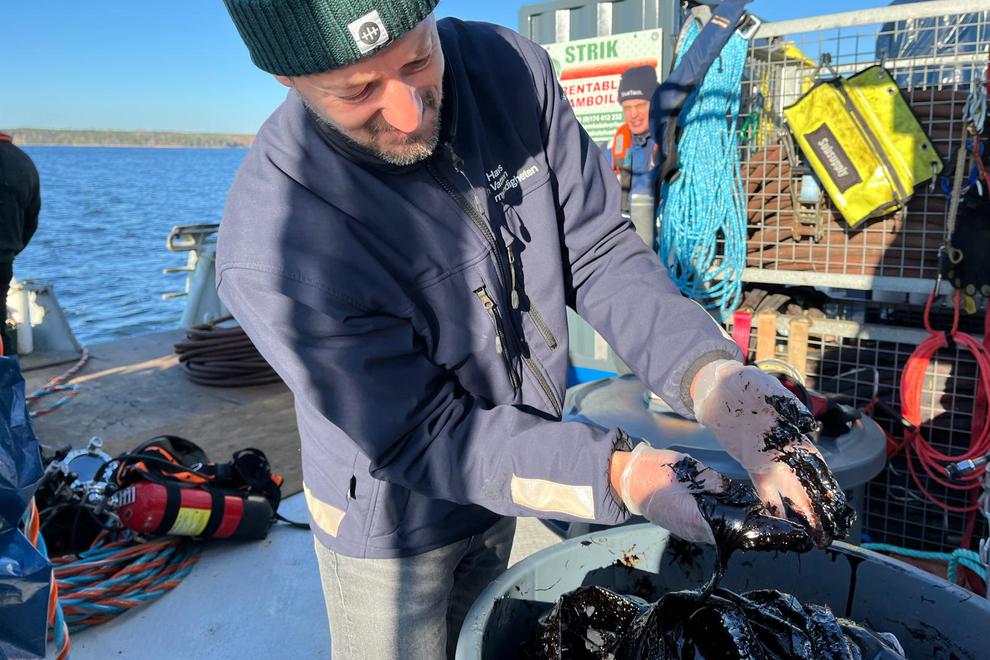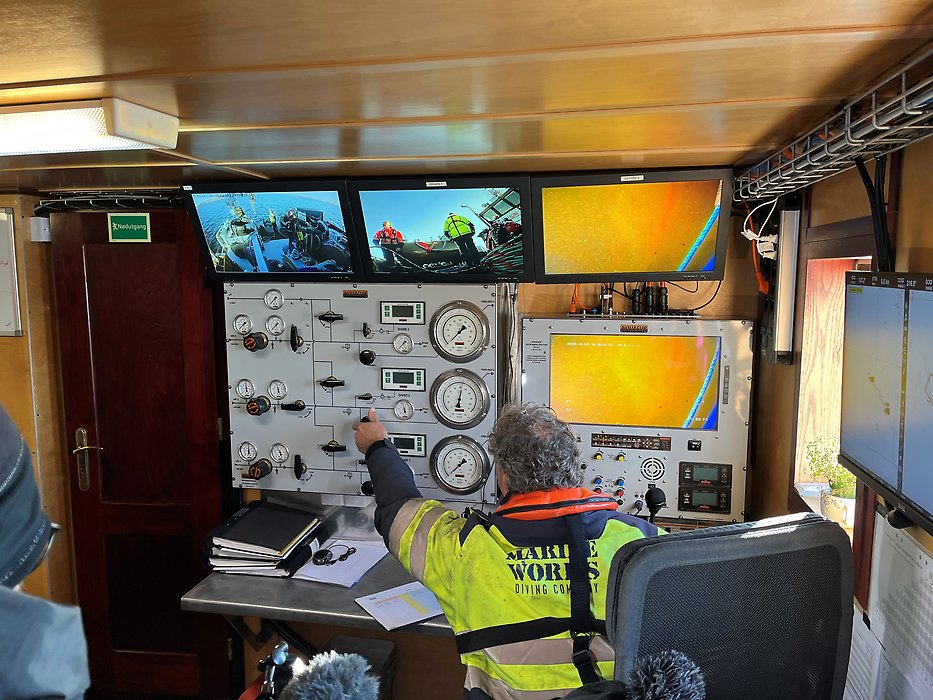Harburg
In the autumn of 2024, a detailed investigation and oil recovery operation was conducted on the wreck of the ship Harburg, led by the Swedish Agency for Marine and Water Management (SwAM) and carried out by Marine Works. During the operation, heavy fuel oil (HFO) and oil-contaminated water were salvaged from the wreck.

The wreck was inspected at numerous locations, primarily by drilling several inspection holes (about 5 cm in diameter) in the hull. Photo: Marine Works / The Swedish Agency for Marine and Water Management.
S/S Harburg was a German cargo ship that sank on February 16, 1957, while en route from Hamburg, Germany, to Liljeholmen, Sweden, carrying a cargo of iron ingots. When the ship passed Lidingö, it collided with a larger oil tanker in the fairway. The accident occurred in dense fog just outside Lidingö. Immediately after the collision, Harburg was pushed under the tanker’s keel and sank quickly. Ten people lost their lives in the collision, but no human remains are today left in the wreck.
Oil leak from the wreck
The wreck was considered an environmental hazard due to the potentially large amounts of oil remaining in the tanks. When Harburg sank, it was estimated to contain between 20,000 to 40,000 liters of oil. The salvage operation on Harburg is an important step in protecting the sensitive archipelago and ensuring that hazardous substances do not enter the sea. Through these efforts, SwAM aims to preserve the marine environment and prevent future damage to the ecosystem.
Consequences of a leak
A major oil leak from Harburg could have had serious consequences for the local ecosystem. Seabirds could suffer oil damage, which would affect their insulation ability and survival. If the oil reaches the seabed, it could impact organisms living there, with potentially toxic effects that could lead to death or reproductive problems. In close proximity to the wreck, there are nature reserves to the north, west, and south. Additionally, a larger oil leak and a following extensive clean-up effort could disrupt maritime traffic, specifically the intensive passenger traffic in the area, including ferry routes to Finland and cruise ships.
Detailed investigation and oil recovery
The detailed investigation and oil recovery work were carried out by the company Marine Works, which was commissioned by SwAM to examine the wreck and recover the oil. The specially adapted work vessel Fatman was used for the operation. The work vessel was anchored in the fairway above Harburg, and diving operations began the same day to inspect the wreck according to the work description. The wreck was inspected at numerous locations, primarily by drilling several inspection holes (about 5 cm in diameter) in the hull.
Through this method, heavy oil was discovered in two fuel tanks – one on the port side and one on the starboard side – heat was then applied in the tanks to allow the sticky heavy oil to be pumped and salvaged into tanks on-board the work vessel. A total of 6 m³ (6,000 liters) of heavy oil and oil-contaminated water were recovered from Harburg. This means that the wreck contained less oil than initially estimated at the time of the sinking, and the remaining amounts of oil had leaked into the marine environment over time.
After the detailed investigation and oil recovery operation, SwAM has removed the wreck from the list of the 30 most environmentally hazardous wrecks in the Swedish coast.

Harburg contained heavy oil, Which is viscous and must be heated before it can be pumped to the work vessel. SwAM senior analyst Fredrik Lindgren shows how the recovered oil looks. Photo: Staffan Ljung/Swedish Agency for Marine and Water Management.
Cost of the measure
Carrying out proactive oil recovery operations on environmentally hazardous wrecks, compared to clean-up operations of water and coastlines after oil spills, provides an overall economic and environmental benefit to society. The successful but complex investigation and recovery operation carried out on Harburg amounted to approximately 12.8 million SEK.
Background
- S/S Harburg was an oil-fired cargo ship built in Rendsburg, Germany, in 1919.
- At the time of its sinking in 1957, it was loaded with iron ingots.
- Length: 53.5 m, Width: 9.4 m, Draft: 5.8 m, Gross Tonnage: 651 tons.





















